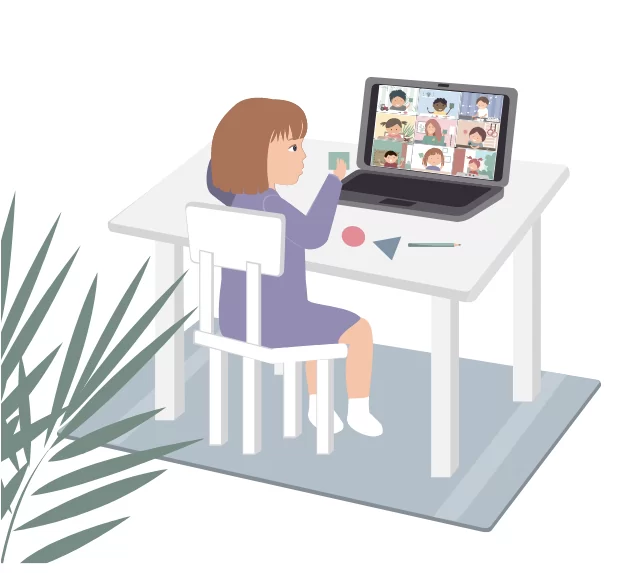
The COVID-19 has caused school closures all across the world. As a result, over 1.2 billion youngsters worldwide are not in school. As a result, education has altered considerably, with the notable emergence of e-learning, in which instruction is done remotely and on digital platforms.
According to research, online learning has been demonstrated to boost information retention and take less time, implying that the changes created by the coronavirus are here to stay.
With this abrupt change away from the classroom in many regions of the world, some are questioning if the acceptance of online education would sustain post-pandemic and how such a shift might affect the global education industry.
What differences will there be in engaging kids in a post-COVID world?
After several months – and over a year for some – of virtual learning, school authorities report that several students are becoming more passive, have a diminished feeling of social connection, and are alienated from their studies.
We recognize the consequences of low-quality online instruction on student success disparities. Still, we don’t completely grasp the effects of social isolation, uneven frameworks, and personal trauma on student participation.
We know that student involvement is still vital for learning and accomplishment, and instructors will most likely need to develop new strategies to encourage and engage their pupils.
What exactly is student involvement, and why is it so important?

According to educational neuroscience specialist Dr David Sousa, student engagement is “the level of attention, motivation, enthusiasm, and favorable motivational connections that kids have when they are studying, be it in the classroom or on their own.”
Increase your motivation to engage in class. They like reaching their educational objectives.
- Are more inclined to persevere in the face of learning problems
- Feel intrinsically inspired to learn new and deeper things.
One of the primary reasons for the importance of student engagement is that the accompanying skills and habits — motivation, the joy of learning, tenacity, and curiosity – prepare students to excel in college and their professions.
What are the advantages of student involvement?
- Student involvement is critical because it influences student accomplishment in kids’ futures, and it can eliminate COVID-19 learning disparities. As previously said, student involvement fosters abilities and habits that provide kids with a higher likelihood of succeeding once they leave school.
- Student involvement appears different depending on whether it is generated by the instructor or the students and their academic assignments.
- Most educators strive for teacher-led engagement. Many teaching programs promote teacher-led methods such as developing strong educator relationships, achieving higher lectures, and utilizing interactive games. Naturally charismatic teachers typically thrive at these strategies.
- However, student-led participation can be far more beneficial. These approaches emphasize the development of demanding learning activities and the assignment of roles, duties, and cooperative structures to students in order for them to participate in these tasks with their peers.
- Engagement stems from peer relationships and the difficulty of the activities rather than exchanges with the teacher.
What do teachers have to say about keeping kids interested and motivated post-COVID?

Teachers may take advantage of the fact that students are thrilled to see their friends again and that some students are prepared to take greater responsibility for their studies. Again, the idea is to harness the power of student-led involvement.
The key distinction is that teacher-driven engagement strategies depend highly on a teacher’s qualifications, experience and personal characteristics. In contrast, student-driven engagement approaches can be learned more effectively through career development.
Teaching an online class is quite different from teaching in person, and when instructors try to duplicate what they do through technology, it frequently falls short. In addition, online learners may have difficulties due to a loss of face-to-face communication between teachers and an extended response time for responding to inquiries.
COVID-19 may have forever altered the globe of higher education. Our goal is that we will be able to return to the school for face-to-face education soon. Meanwhile, providing a balanced student engagement strategy will assist students in being more involved and result in greater learning results. Online education is growing, and we must continue to find more efficient methods of achieving the same classroom cultures in online classrooms that we do in face-to-face classes.
Assign pupils real-world jobs and responsibilities

When students have autonomous frameworks, they may become more active, involved self-directed learners. When students work alone in most classrooms, the teacher’s responsibility is to help them review their work, answer their questions, and provide coaching and feedback. Instead, progressively empower students to self-monitor their student learning, coach their classmates, and seek solutions to their queries from one another and their resources. Students soon grow excellent at tailoring their learning to the requirements of their peers.
Adjust as needed based on the degree of participation of the kids

It’s critical to figure out how to tell if your pupils are interested and modify lessons fast if they aren’t. Most professors read the room with their senses, but this does not always work – students might be good at seeming to be attentive. Teachers may make better educated, data-driven judgments when using a system or tool to monitor student involvement.
The most efficient technique to monitor participation is to engage students through the process by applying the above-mentioned learning objectives and success criteria. Learning objectives and success factors keep students motivated and provide a tangible means to assess if pupils are engaged in their learning.
Conclusion
The COVID-19 epidemic has compelled all of us to make significant changes in our everyday lives. When practicable, businesses have shifted to remote employment; K-12 schools have adopted distant learning out of necessity. As a result, many college students who were previously engaged in on-campus programs now find themselves in unexpected online learning.






